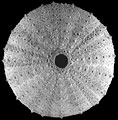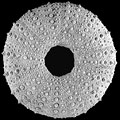The Echinoid Directory
Sterechinus Koehler, 1900, p. 815.
| Diagnostic Features |
|
|---|---|
| Distribution | Recent; Antarctica. |
| Name gender | masculine |
| Type | Sterechinus antarcticus Koehler, 1901, by original designation. |
| Species Included |
|
| Classification and/or Status |
|
| Remarks | Differs from Echinus in having a hemicyclic apical disc with a proportionally much larger periproct, and in having plates much more densely covered in granulation. In life this provides the animal with a dense, hair-like felt in amongst the rather fine primary spines. Confined today to the circum-Antarctic region. Very similar to Selenechinus which differs primarily in that its globiferous pedicellariae have a single lateral tooth. In terms of test characters the two are almost identical save that Sterechinus has a much larger periproct in comparison to the size of its apical disc than Selenechinus. Koehler, A. 1900 (December). Bulletin de l'Academie Belgique (3) 38, p. 815. |



